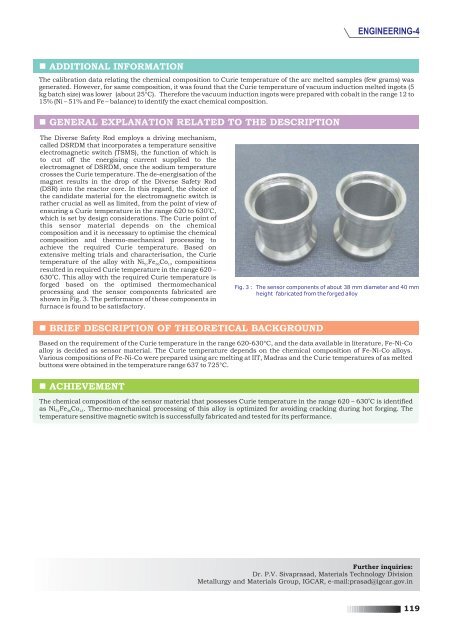Development of Sensor Material for Application in Temperature ...
Development of Sensor Material for Application in Temperature ...
Development of Sensor Material for Application in Temperature ...
Create successful ePaper yourself
Turn your PDF publications into a flip-book with our unique Google optimized e-Paper software.
ENGINEERING-4<br />
ADDITIONAL INFORMATION<br />
The calibration data relat<strong>in</strong>g the chemical composition to Curie temperature <strong>of</strong> the arc melted samples (few grams) was<br />
generated. However, <strong>for</strong> same composition, it was found that the Curie temperature <strong>of</strong> vacuum <strong>in</strong>duction melted <strong>in</strong>gots (5<br />
kg batch size) was lower (about 25°C). There<strong>for</strong>e the vacuum <strong>in</strong>duction <strong>in</strong>gots were prepared with cobalt <strong>in</strong> the range 12 to<br />
15% (Ni – 51% and Fe – balance) to identify the exact chemical composition.<br />
GENERAL EXPLANATION RELATED TO THE DESCRIPTION<br />
The Diverse Safety Rod employs a driv<strong>in</strong>g mechanism,<br />
called DSRDM that <strong>in</strong>corporates a temperature sensitive<br />
electromagnetic switch (TSMS), the function <strong>of</strong> which is<br />
to cut <strong>of</strong>f the energis<strong>in</strong>g current supplied to the<br />
electromagnet <strong>of</strong> DSRDM, once the sodium temperature<br />
crosses the Curie temperature. The de-energisation <strong>of</strong> the<br />
magnet results <strong>in</strong> the drop <strong>of</strong> the Diverse Safety Rod<br />
(DSR) <strong>in</strong>to the reactor core. In this regard, the choice <strong>of</strong><br />
the candidate material <strong>for</strong> the electromagnetic switch is<br />
rather crucial as well as limited, from the po<strong>in</strong>t <strong>of</strong> view <strong>of</strong><br />
o<br />
ensur<strong>in</strong>g a Curie temperature <strong>in</strong> the range 620 to 630 C,<br />
which is set by design considerations. The Curie po<strong>in</strong>t <strong>of</strong><br />
this sensor material depends on the chemical<br />
composition and it is necessary to optimise the chemical<br />
composition and thermo-mechanical process<strong>in</strong>g to<br />
achieve the required Curie temperature. Based on<br />
extensive melt<strong>in</strong>g trials and characterisation, the Curie<br />
temperature <strong>of</strong> the alloy with Ni51Fe36Co13<br />
compositions<br />
resulted <strong>in</strong> required Curie temperature <strong>in</strong> the range 620 –<br />
o<br />
630 C. This alloy with the required Curie temperature is<br />
<strong>for</strong>ged based on the optimised thermomechanical<br />
process<strong>in</strong>g and the sensor components fabricated are<br />
shown <strong>in</strong> Fig. 3. The per<strong>for</strong>mance <strong>of</strong> these components <strong>in</strong><br />
furnace is found to be satisfactory.<br />
Fig. 3 : The sensor components <strong>of</strong> about 38 mm diameter and 40 mm<br />
height fabricated from the <strong>for</strong>ged alloy<br />
BRIEF DESCRIPTION OF THEORETICAL BACKGROUND<br />
Based on the requirement <strong>of</strong> the Curie temperature <strong>in</strong> the range 620-630°C, and the data available <strong>in</strong> literature, Fe-Ni-Co<br />
alloy is decided as sensor material. The Curie temperature depends on the chemical composition <strong>of</strong> Fe-Ni-Co alloys.<br />
Various compositions <strong>of</strong> Fe-Ni-Co were prepared us<strong>in</strong>g arc melt<strong>in</strong>g at IIT, Madras and the Curie temperatures <strong>of</strong> as melted<br />
buttons were obta<strong>in</strong>ed <strong>in</strong> the temperature range 637 to 725°C.<br />
ACHIEVEMENT<br />
o<br />
The chemical composition <strong>of</strong> the sensor material that possesses Curie temperature <strong>in</strong> the range 620 – 630 C is identified<br />
as Ni51Fe36Co 13. Thermo-mechanical process<strong>in</strong>g <strong>of</strong> this alloy is optimized <strong>for</strong> avoid<strong>in</strong>g crack<strong>in</strong>g dur<strong>in</strong>g hot <strong>for</strong>g<strong>in</strong>g. The<br />
temperature sensitive magnetic switch is successfully fabricated and tested <strong>for</strong> its per<strong>for</strong>mance.<br />
Further <strong>in</strong>quiries:<br />
Dr. P.V. Sivaprasad, <strong>Material</strong>s Technology Division<br />
Metallurgy and <strong>Material</strong>s Group, IGCAR, e-mail:prasad@igcar.gov.<strong>in</strong><br />
119
















